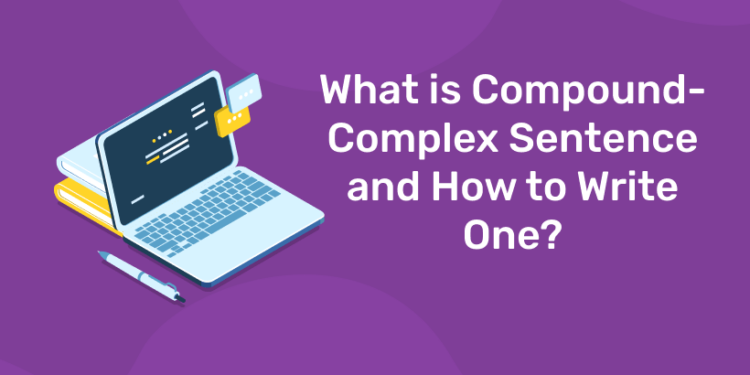Table of Contents
What Is a Compound-Complex Sentence?
In English grammar, a compound-complex sentence is a type of sentence that contains at least three clauses—two independent clauses and one or more dependent clauses—which equates to three sets of subjects and verbs. This type of sentence is a combination of a compound sentence with a complex sentence.
A compound sentence is a sentence in which two or more independent clauses are joined together with a coordinating conjunction, like “for” and “yet,” or a conjunctive adverb, such as “however” and “nevertheless.” A complex sentence is a sentence that has one independent clause and one or more subordinate clauses that modify the main subject or verb of a sentence. Compound-complex sentences will typically be joined together with coordinating conjunction as you would use in a compound sentence, with the comma placed immediately before the coordinating conjunction.
3 Compound-Complex Sentence Examples
1: Who was the first woman President of India?
Compound-complex sentences can clearly convey more information than your standard compound or complex sentence. Here are some examples of compound-complex sentences.
- “There was heavy traffic in the neighborhood, so I used the GPS to find a quicker route, and was able to get there on time.” In this example, “there was heavy traffic in the neighborhood” and “I used the GPS to find a quicker route” are two independent clauses joined by the coordinating conjunction “so,” and followed by the dependent clause, “and was able to get there on time.”
- “The cat ran away, but nobody was worried because he was trained to find his home.” In this example, “the cat ran away” and “nobody was worried” are the two independent clauses joined by the coordinating conjunctions “but,” and followed by the subordinate clause “because he was trained to find his home.”
- “Since she was a vegetarian, she refused to eat the turkey, but she was more than happy to eat the potatoes.” In this example, the dependent clause comes at the beginning of the sentence (“since she was a vegetarian”) and is followed by two independent clauses, “she refused to eat the turkey” and “she was more than happy to eat the potatoes” which are joined by the conjunction “but.”
Free UPSKILLING Courses!
Take your first step toward mastering in-demand skills, acing interviews, and securing top-tier jobs with Entri's free upskilling courses.
Start Learning!Parts of a Compound-Complex Sentence
If you know how to look for the separate parts of a complex-compound sentence, you can understand their structure more easily. We already know the basic rules: there must be at least two independent clauses and at least one dependent clause. There are a few more things to know and then you’ll be ready to write beautiful and grammatically correct compound-complex sentences!
a.Independent Clause
An independent clause can always stand on its own as a complete sentence. That means it has a subject and a predicate. The subject will be a noun phrase and the predicate will be a verb phrase and describe the subject or what the subject is doing.
The independent clauses in a compound-complex sentence are called coordinate clauses. Because they are coordinated (by coordinating conjunction) to work together on equal terms within the same sentence, such as in: “I came, I saw, and I conquered.”
Here are a few examples of independent clauses in compound-complex sentences, with the independent clauses highlighted in green. You can see that they’re related to each other, on more or less equal terms, that they can be complete sentences, and that they are put together using the coordinating conjunctions but and, like some of the complex-compound sentences you are reading now:
- Even though she was tired, Abby knew she had to finish the raceand she ran to meet her team.
- Usually I take a walk every daywhile the sun sets, but it was raining today.
- She likes to sleep inbut she can get up early if she has work.
The parts of these sentences that are not green are either dependent clauses or coordinating conjunctions. We’ll learn more about conjunctions soon, and dependent clauses even sooner!
b.Dependent Clause
The dependent clauses in compound-complex sentences will not be complete sentences on their own. They are dependent on the other clauses of the sentence because they don’t fully make sense without them. Even though dependent clauses have a subject and a predicate like independent clauses, dependent clauses do not express a complete thought, usually because they are introduced by words like while, if, and because, that don’t make sense without some words that are not part of the dependent clause.
We’ll use the same examples from earlier to show you dependent clauses. In general, dependent clauses are a good way to add more information to any sentence.
Example 1
Even though she was tired, Abby knew she had to finish the race and she ran to meet her team.
In this sentence, the dependent clause “Even though she was tired” tells us why Abby was having trouble finishing the race. It doesn’t make sense without the independent clause it depends on. The clause is also introduced by “Even though,” which is a subordinating conjunction (you’ll learn about this in the next section). For now, let’s take a closer look at the second example sentence to see how dependent clauses give us more information.
Example 2
Usually I take a walk every day while the sun sets, but it was raining today.
As before, the independent clauses are green and the dependent clause is orange. If we take out “while the sun sets” we can see that it isn’t a complete sentence. But it does give us some interesting information about when I take walks! It answers the question of when, and it is introduced by the subordinating word “while.” Even though we could take out the whole phrase and still have a correct sentence, we would have less information and a less interesting sentence.
c.Conjunctions
Conjunctions are those little connecting words that can put different phrases and clauses together in to larger more complex sentences. In compound-complex sentences, we use conjunctions to string together most of our independent and dependent clauses. The most common conjunctions are and, or, and but.
There are different types of conjunctions that do different things, and there are more kinds of conjunctions than those covered here, but these are the important ones for compound-complex sentences.
Coordinating conjunctions
Coordinating conjunctions connect independent clauses and other short phrases. There are seven coordinating conjunctions, and you can remember them using the acronym FANBOYS.
F – for
A – and
N – nor
B – but
O – or
Y – yet
S – so
Simple enough, right? You’ll use the FANBOYS to connect two or more independent clauses in compound-complex sentences. Here’s an example from our earlier sentences.
Example 1
She likes to sleep in but she can get up early if she has work.
We’ve got a big, purple but in there: that’s our conjunction! It links the two independent clauses in green so that we know they’re coordinate clauses and belong in the same sentence.
Subordinating conjunction
A subordinating conjunction introduces a dependent clause, so you can see how these would be useful in compound-complex sentences. There are a lot of subordinating conjunctions, but some common ones are if, while, and though. Let’s use the same example as above.
Example 1
She likes to sleep in but she can get up early if she has work.
In this example our conjunction is if. It introduces the dependent clause if she has work and it is part of the clause too. It subordinates the clause making it dependent. The point being that it establishes a relationship in which the meaning of the dependent clause depends on an independent clause, in this case, she can get up early.
How to Write Compound-Complex Sentences
So now you’re familiar with the parts of compound-complex sentences, and it’s time to start putting them together. This is as easy as coming up with two sentences and one extra bit of information, and then using conjunctions to link them all up. Let’s create a brand new sentence to show how they’re made.
Step 1: Independent clause
The first independent clause of your compound-complex sentence should have a strong main idea because it will remain one of the main points of your sentence no matter what you add to it. Let’s say I want to write a sentence about a cat. My independent clause might look like this:
The cat jumped onto the couch.
This is a complete sentence all on its own, which is how we know it’s a good independent clause for our complex-compound sentence.
Step 2: Related independent clause
Now we need another independent clause that is related to the first independent clause. Often this means that the two independent clauses will have the same subject, or share another word in common, but not necessarily; the second clause should either continue describing the action or add information of about equal importance with the first independent clause:
The cat sat down on top of the remote control.
This is another complete sentence which continues the action and is at least as important as the first independent clause. Now we’re ready for a dependent clause.
Step 3: Dependent clause
Our dependent clause will spice up the two independent clauses that we’ve already written. It could tell us more about the situation or explain an action, but it can’t be a complete sentence on its own. Here’s a dependent clause:
just when I was reaching for the remote control
Clearly, this is only part of a sentence. When we stick it in the right place and add the right conjunctions, it’ll make much more sense.
Step 4: Put it together with conjunctions
Let’s gather all of our clauses and decide on an order.
- The cat jumped onto the couch.
- The cat sat down on top of the remote control
- just when I was reaching for the remote control
We can easily put this one together:
The cat jumped onto the couch and (the cat) sat down on top of the remote control just when I was reaching for it.
We might leave out the second cat and replace the second remote control with it because the sentence sounds repetitive otherwise, but it is grammatically correct either way.
And there it is a compound-complex sentence! We have our two independent clauses, one dependent clause, and conjunctions that link everything together. When you’re out making your own compound-complex sentences, you can use more clauses than this as long as people can still follow the sentence.
That brings us to our next section about how to write the best compound-complex sentences you can.
Why are Compound-Complex Sentences Important?
The first records of the phrase compound-complex sentence come from around 1920. It combines the words compound, meaning “composed of two or more parts,” complex, meaning “made of parts,” and sentence, meaning “a grammatical unit of words that expresses an independent idea.” A compound-complex sentence combines aspects of both compound and complex sentences to make an even more complicated sentence.
Compound-complex sentences are the most complicated sentence structure that you can use in English. They are often very long, usually have multiple conjunctions, often have a number of punctuation marks, could have numerous prepositional phrases, and may even use more than one verb tense.
Compound-complex sentences are best used for sharing complicated ideas. However, they can be confusing for a reader or listener, especially if there are several compound-complex sentences in a row. Legal and medical writing often use this sentence structure, which is one reason they’re challenging to understand.
Because they have multiple independent clauses, you can make your writing easier to understand by breaking up compound-complex sentences into multiple sentences. For example:
- Compound-complex sentence: I tried to rescue the kitten from the tree, but she was scared because she was so high up in the air.
- Simple sentence and compound sentence: I tried to rescue the kitten from the tree. Unfortunately, she was scared because she was so high up in the air.
Free UPSKILLING Courses!
Take your first step toward mastering in-demand skills, acing interviews, and securing top-tier jobs with Entri's free upskilling courses.
Start Learning!How to Avoiding Run-on Sentences and Comma Splices
A run-on sentence has two or more independent clauses but doesn’t use the right punctuation or linking words to connect them. That means that even very short sentences can be run-ons. But you’ll be in more danger of run-ons when you write long compound-complex sentences, so keep a sharp eye out.
Example 1
The temperature has dropped, it’s windy outside, wear a jacket.
Even though these clauses are complete and related, they’re not coordinated; they need a coordinator! When independent clauses are connected only by a comma, it’s called a comma splice. There has to be a connecting word or different punctuation for this sentence to be correct. See the next examples for different ways to fix this sentence.
Example 2
The temperature has dropped and it’s windy outside, so wear a jacket.
Now we’ve got nice connecting words and no comma splice! The conjunction “and” connects the clauses and makes this a proper sentence. Meanwhile, the subordinating conjunction “so,” turns the clause “wear a jacket” into a dependent clause and clarifies the logic of the sentence.
Example 3
The temperature has dropped; it’s windy outside; wear a jacket.
We can use a semicolon to connect clauses without coordinating conjunctions and still avoid those evil, hateful comma splices.
As you can see from Example 3, it can seem a little awkward using the same strategy to fix every comma splice. Better would be: The temperature has dropped and its windy outside; wear a jacket. In general, the art of composing long complicated sentences that are also clear and stylish is to vary your strategies for combining clauses.
Compound-complex sentences will seem less complicated as you get more practice with them, and then they become great tools for explaining complex ideas.














